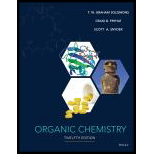
Concept explainers
Interpretation:
The number of protons and neutrons in the isotopes of nitrogen is to be determined.
Concept introduction:
Isotopes are the two or more atoms that have same number of protons but different number of neutrons.
In the periodic table,
Mass number is the sum of number of neurons and number of protons present in the nucleus of the atom. Mass number is represented by A. Mathematically, mass number is calculated as:
Here, A is the
Answer to Problem 1PP
Solution:
Explanation of Solution
The atomic number (Z) from the symbol for nitrogen is
The number of protons is same as the atomic number. So, the numbers of protons for both the isotopes of nitrogen are 7.
The total number of protons and neutrons is equal to the atomic mass. Therefore, the number of neutrons is calculated as follows:
Rearrange the above equation:
Here, A is the atomic mass of the element.
For
For
For
For
Want to see more full solutions like this?
Chapter 1 Solutions
Organic Chemistry
- Which represent the same compound?arrow_forwardProblem Name each of the following anions and give the name and formula of the acid derived from it: (a) Br-; (b) IO3 -; (c) CN-; (d) SO4 2-; (e) NO2 -.arrow_forwardGive a clear handwritten answer with explanation....please give answer all please.....give the name given compounds pleasearrow_forward
- Cysteine, whose molecular model and structural formula are illustrated here is an important amino acid and a constituent of many living things. What is its molecular formula?arrow_forwardGive only typing answer with explanation and conclusion name the following compounds.Then draw the compound and one isomer of each compund.arrow_forwardThe formula for an amine is HNR3+, where R is most often a hydrogen atom or a carbon chain of varying length. Group of answer choices True Falsearrow_forward
- State the number of hydrogens bonded to each labeled carbon in the following substance and give its molecular formula. (The molecular formula answer is case-sensitive. The order of atoms should be carbon, then hydrogen, then others in alphabetical order.)arrow_forwardIn pent-2-yne (CH3CCCH2CH3), there are four atoms in a straight line. Use dashed lines and wedges to draw a three-dimensional representation of this molecule, and circle the four atoms that are in a straight line.arrow_forwardOn the left side, why is the fluorine prioritized more than the two carbons? Don't two carbons' atomic numbers combined outweigh the atomic number of fluorine?arrow_forward
- Provide a systematic name (IN SMALL LETTERS except for E/Z and R/S, NO SPACES) for each of the given compounds showm in the figure.arrow_forwardfor the following condensed structural formulas, determine the class of compound AND chemical formula. Please make sure to also draw the line-angle formula for each.arrow_forwardWhat is the name of a, b, c, and d in the sentences given below? Red cabbage leaves contain ' a ' , an organic dye. This substance gives the color ' b ' in acidic environment, ' c ' in neutral medium and ' d ' in basic environment.arrow_forward
 ChemistryChemistryISBN:9781305957404Author:Steven S. Zumdahl, Susan A. Zumdahl, Donald J. DeCostePublisher:Cengage Learning
ChemistryChemistryISBN:9781305957404Author:Steven S. Zumdahl, Susan A. Zumdahl, Donald J. DeCostePublisher:Cengage Learning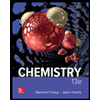 ChemistryChemistryISBN:9781259911156Author:Raymond Chang Dr., Jason Overby ProfessorPublisher:McGraw-Hill Education
ChemistryChemistryISBN:9781259911156Author:Raymond Chang Dr., Jason Overby ProfessorPublisher:McGraw-Hill Education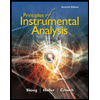 Principles of Instrumental AnalysisChemistryISBN:9781305577213Author:Douglas A. Skoog, F. James Holler, Stanley R. CrouchPublisher:Cengage Learning
Principles of Instrumental AnalysisChemistryISBN:9781305577213Author:Douglas A. Skoog, F. James Holler, Stanley R. CrouchPublisher:Cengage Learning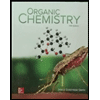 Organic ChemistryChemistryISBN:9780078021558Author:Janice Gorzynski Smith Dr.Publisher:McGraw-Hill Education
Organic ChemistryChemistryISBN:9780078021558Author:Janice Gorzynski Smith Dr.Publisher:McGraw-Hill Education Chemistry: Principles and ReactionsChemistryISBN:9781305079373Author:William L. Masterton, Cecile N. HurleyPublisher:Cengage Learning
Chemistry: Principles and ReactionsChemistryISBN:9781305079373Author:William L. Masterton, Cecile N. HurleyPublisher:Cengage Learning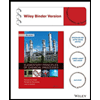 Elementary Principles of Chemical Processes, Bind...ChemistryISBN:9781118431221Author:Richard M. Felder, Ronald W. Rousseau, Lisa G. BullardPublisher:WILEY
Elementary Principles of Chemical Processes, Bind...ChemistryISBN:9781118431221Author:Richard M. Felder, Ronald W. Rousseau, Lisa G. BullardPublisher:WILEY





